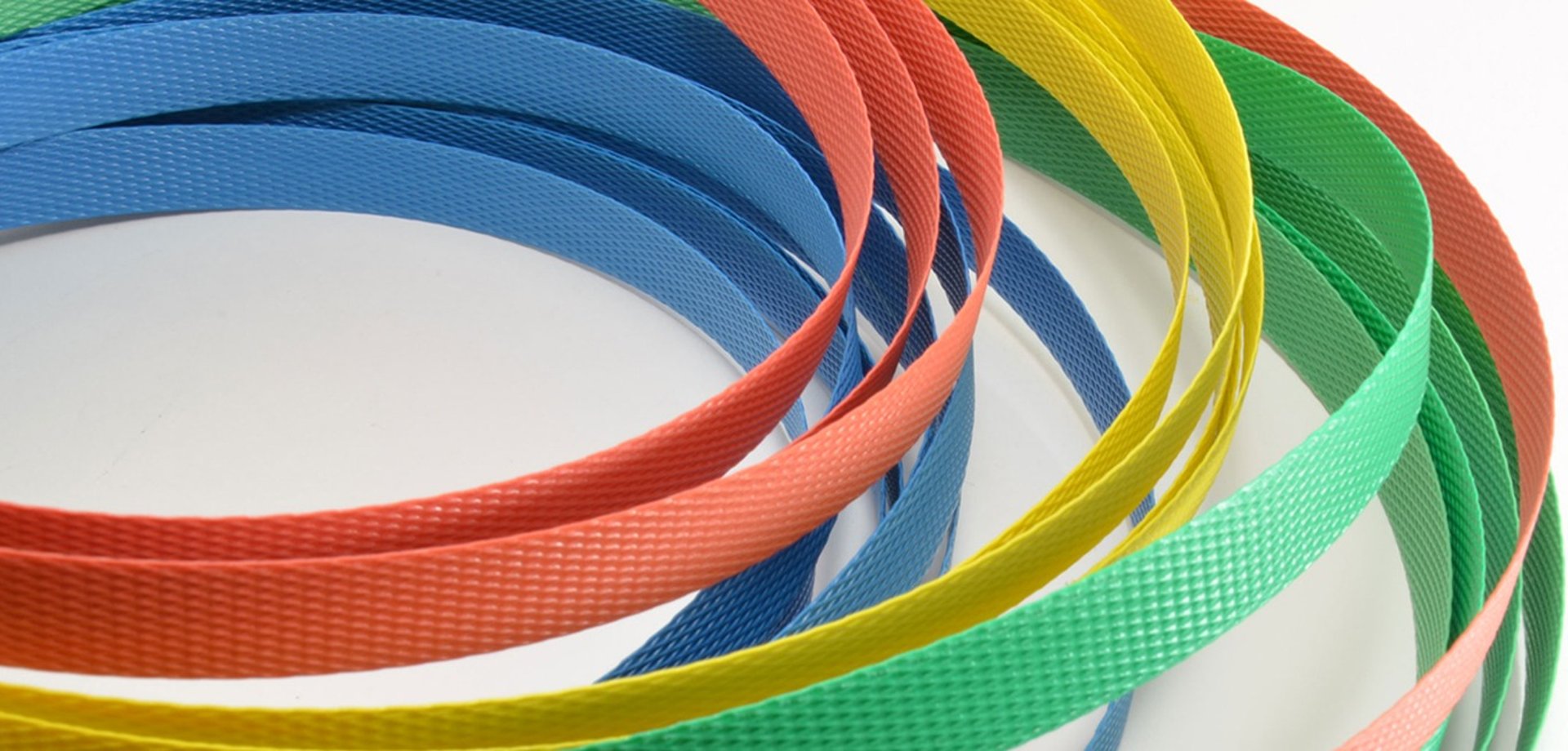
Strapping Tape
Polypropylene
Strapping tape is a versatile, durable material commonly used in industrial and packaging applications for bundling, securing, and reinforcing products. It's often used as an alternative to steel or polypropylene strapping due to its lighter weight, ease of handling, and ability to provide strong tensile strength.
Material Composition:
Polyester (PET) and Polypropylene (PP) are the two main types of plastic strapping tape. PET is stronger, more resilient, and resistant to stretching, making it ideal for heavy-duty applications. PP is more flexible and is typically used for lighter packaging.
Strength:
Plastic strapping tape offers significant tensile strength, allowing it to secure products tightly without breaking. PET strapping, in particular, has high strength and low elongation, which helps in maintaining tension over long periods.
Durability:
It can withstand harsh environmental conditions, such as exposure to moisture, UV rays, and temperature fluctuations, making it suitable for indoor and outdoor applications.
Adhesive:
Some plastic strapping tapes have a pressure-sensitive adhesive backing, allowing them to stick securely to themselves without requiring heat or extra tools. This feature makes them quick and easy to apply, reducing labor time.
Size and Width:
Plastic strapping tapes come in various widths, thicknesses, and lengths. Standard widths typically range from 1/2 inch to 2 inches (12mm to 50mm), but custom sizes are also available.
Applications:
Packaging: It’s commonly used in the packaging industry to bundle products together, such as boxes, packages, and palletized goods.
Shipping and Logistics: It helps secure transportation items, particularly in sectors that deal with heavy or bulky items.
Storage: Plastic strapping is also used to bundle and organize warehouse goods.
Advantages:
Cost-effective: Generally more affordable than other strapping materials like steel.
Lightweight: Easier to handle compared to traditional metal strapping.
Flexible: It can be adjusted and repositioned to some extent before being secured completely.
Non-corrosive: Unlike metal strapping, plastic tape doesn’t rust or corrode when exposed to moisture.
Disadvantages:
Less tension: While strong, plastic strapping tape doesn't always offer the same level of tension as steel strapping.
Environmental concerns: While recyclable, plastic strapping may not be as environmentally friendly as other options, especially if not disposed of properly.
Key Features and Characteristics
Material Composition
Polyester (PET) and Polypropylene (PP) are the two main types of plastic strapping tape. PET is stronger, more resilient, and resistant to stretching, making it ideal for heavy-duty applications. PP is more flexible and is typically used for lighter packaging.
Strength
Plastic strapping tape offers significant tensile strength, allowing it to secure products tightly without breaking. PET strapping, in particular, has high strength and low elongation, which helps in maintaining tension over long periods.
Durability
It can withstand harsh environmental conditions, such as exposure to moisture, UV rays, and temperature fluctuations, making it suitable for indoor and outdoor applications.
Adhesive
Some plastic strapping tapes have a pressure-sensitive adhesive backing, allowing them to stick securely to themselves without requiring heat or extra tools. This feature makes them quick and easy to apply, reducing labor time.
Size and Width
Plastic strapping tapes come in various widths, thicknesses, and lengths. Standard widths typically range from 1/2 inch to 2 inches (12mm to 50mm), but custom sizes are also available.
Applications
Packaging: It’s commonly used in the packaging industry to bundle products together, such as boxes, packages, and palletized goods.
Shipping and Logistics: It helps secure transportation items, particularly in sectors that deal with heavy or bulky items.
Storage: Plastic strapping is also used to bundle and organize warehouse goods.
Advantages
Cost-effective: Generally more affordable than other strapping materials like steel.
Lightweight: Easier to handle compared to traditional metal strapping.
Flexible: It can be adjusted and repositioned to some extent before being secured completely.
Non-corrosive: Unlike metal strapping, plastic tape doesn’t rust or corrode when exposed to moisture.
Disadvantages
Less tension: While strong, plastic strapping tape doesn't always offer the same level of tension as steel strapping.
Environmental concerns: While recyclable, plastic strapping may not be as environmentally friendly as other options, especially if not disposed of properly.
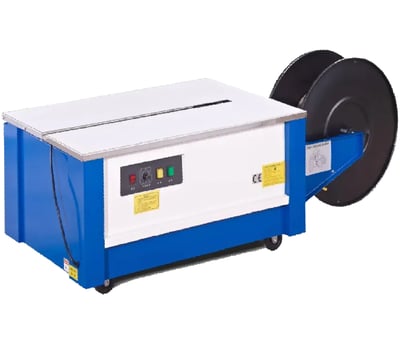

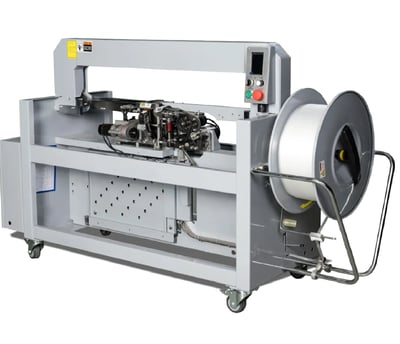

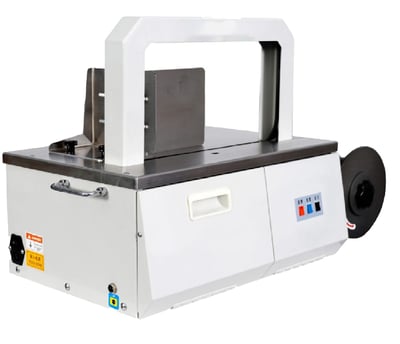

Our products can be used with any of the machines listed below and can be used without machines.
Semi-Automated
Fully Automated
Table Top - Fully Automated
Summary
In short, strapping tape is a practical and cost-effective option for bundling and securing products, offering a combination of strength, flexibility, and ease of use in a variety of industries.


Embossed Tapes
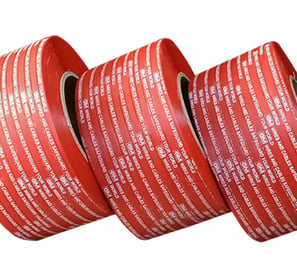

Name Printed Tapes
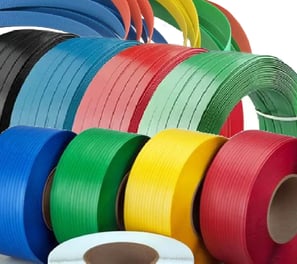

Different Color Tapes
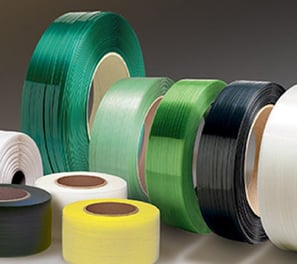

Strength & Custom Specified Tapes
Our Specifications
Material
Polyester (PET): Stronger and more durable than polypropylene, suitable for heavier loads and demanding applications.
Polypropylene (PP): Lightweight, cost-effective, and commonly used for light to medium-duty applications.
Polyvinyl Chloride (PVC): More flexible and resistant to abrasion, but less commonly used in strapping compared to PP and PET.
Thickness
The thickness of strapping tape typically ranges from 0.5 mili (12.7 microns) to 2 mili (50.8 microns). Heavier-duty tapes will have a thicker gauge.
The thickness determines the tape's tensile strength, with thicker tapes offering more resistance to stretching and higher load capacities.
Width
Plastic strapping tapes are usually available in widths between 1/2 inch (12.7 mm) to 2 inches (50.8 mm).
The width is chosen based on the load being secured. Wider tapes generally offer higher strength and stability.
Tensile Strength
Tensile strength is a critical specification and indicates the maximum load the tape can withstand before breaking.
For example, a polyester (PET) strapping tape could have a tensile strength ranging from 300 lbs (136 kg) to 1,000 lbs (453 kg) or more, depending on the application.
Polypropylene (PP) typically has a lower tensile strength than PET and is used for lighter loads.
Breaking Strength
Related to tensile strength, breaking strength refers to the force at which the tape will break when under stress. It is typically measured in pounds (lbs) or kilograms (kg).
Elongation
Elongation refers to the percentage of stretch the tape will undergo before breaking.
Polyester strapping has low elongation (around 5-10%), meaning it is resistant to stretching.
Polypropylene strapping typically has higher elongation, which means it can stretch more but may not be as effective in high-tension applications.
Core Size
Strapping tapes are usually wound on a cardboard or plastic core. Standard core sizes are 8 inches (203 mm) or 10 inches (254 mm) in diameter.
Core size is important when determining compatibility with strapping dispensers.
Color
Plastic strapping tapes come in various colors, though black, white, and transparent are the most common.
The color does not typically affect performance but may be chosen for branding or visibility.
Coating
Hot Melt Coated: Provides better adhesion for certain surfaces and improves the seal integrity when used with heat sealing tools.
Friction Welded Coating: Used for high-strength applications that require the tape to be welded to itself or another surface.
Temperature Resistance
Plastic strapping tapes have varying levels of resistance to temperature extremes.
Polyester (PET) tape can typically withstand higher temperatures than polypropylene (PP), which may degrade in high-heat environments.
UV Resistance
Some plastic strapping tapes, especially those for outdoor use, come with UV-resistant coatings to prevent degradation from sun exposure. UV-resistant tapes are used in environments where the tape will be exposed to sunlight over extended periods.
Stretch and Recovery
Polyester (PET) tapes have good "elastic recovery," meaning they can stretch and return to their original length when the load is removed.
Polypropylene (PP) tapes generally have lower recovery and may deform permanently if overstretched.
Packaging and Usage
Strapping tapes are used with manual or automatic dispensers, which vary in size based on the width and roll diameter of the tape.
Specific applications may require the use of specialized tools like sealers (for heat-sealing) or friction welders.
Safety and Environmental Considerations
Recyclable Strapping: Some types of plastic strapping (especially PET) can be recycled, while others may be non-recyclable.
Non-toxic: Most strapping tapes are non-toxic, but it’s important to check whether the tape meets regulatory standards, especially if used in food-related applications.
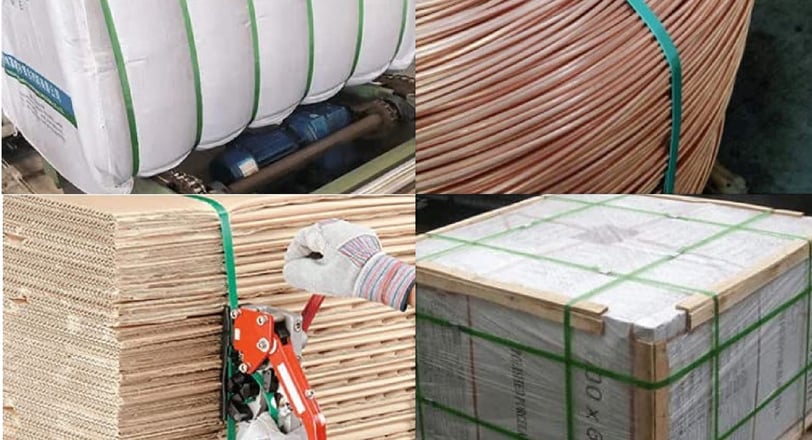

Standard Hand Grade Polypropylene
Standard Machine Grade Polypropylene
1. Material
Polypropylene (PP): Lightweight, cost-effective, and commonly used for light to medium-duty applications.
Polyester (PET): Stronger and more durable than polypropylene, suitable for heavier loads and demanding applications.
Polyvinyl Chloride (PVC): More flexible and resistant to abrasion, but less commonly used in strapping compared to PP and PET.
2. Thickness
The thickness of strapping tape typically ranges from 0.5 mili (12.7 microns) to 2 mili (50.8 microns). Heavier-duty tapes will have a thicker gauge.
The thickness determines the tape's tensile strength, with thicker tapes offering more resistance to stretching and higher load capacities.
3. Width
Plastic strapping tapes are usually available in widths between 1/2 inch (12.7 mm) to 2 inches (50.8 mm).
The width is chosen based on the load being secured. Wider tapes generally offer higher strength and stability.
4. Tensile Strength
Tensile strength is a critical specification and indicates the maximum load the tape can withstand before breaking.
For example, a polyester (PET) strapping tape could have a tensile strength ranging from 300 lbs (136 kg) to 1,000 lbs (453 kg) or more, depending on the application.
Polypropylene (PP) typically has a lower tensile strength than PET and is used for lighter loads.
5. Breaking Strength
Related to tensile strength, breaking strength refers to the force at which the tape will break when under stress. It is typically measured in pounds (lbs) or kilograms (kg).
6. Elongation
Elongation refers to the percentage of stretch the tape will undergo before breaking.
Polyester strapping has low elongation (around 5-10%), meaning it is resistant to stretching.
Polypropylene strapping typically has higher elongation, which means it can stretch more but may not be as effective in high-tension applications.
7. Core Size
Strapping tapes are usually wound on a cardboard or plastic core. Standard core sizes are 8 inches (203 mm) or 10 inches (254 mm) in diameter.
Core size is important when determining compatibility with strapping dispensers.
8. Color
Plastic strapping tapes come in various colors, though black, white, and transparent are the most common.
The color does not typically affect performance but may be chosen for branding or visibility.
9. Coating
Hot Melt Coated: Provides better adhesion for certain surfaces and improves the seal integrity when used with heat sealing tools.
Friction Welded Coating: Used for high-strength applications that require the tape to be welded to itself or another surface.
10. Temperature Resistance
Plastic strapping tapes have varying levels of resistance to temperature extremes.
Polyester (PET) tape can typically withstand higher temperatures than polypropylene (PP), which may degrade in high-heat environments.
11. UV Resistance
Some plastic strapping tapes, especially those for outdoor use, come with UV-resistant coatings to prevent degradation from sun exposure. UV-resistant tapes are used in environments where the tape will be exposed to sunlight over extended periods.
12. Stretch and Recovery
Polyester (PET) tapes have good "elastic recovery," meaning they can stretch and return to their original length when the load is removed.
Polypropylene (PP) tapes generally have lower recovery and may deform permanently if overstretched.
13. Packaging and Usage
Strapping tapes are used with manual or automatic dispensers, which vary in size based on the width and roll diameter of the tape.
Specific applications may require the use of specialized tools like sealers (for heat-sealing) or friction welders.
14. Safety and Environmental Considerations
Recyclable Strapping: Some plastic strapping (especially PET) can be recycled, while others may be non-recyclable.
Non-toxic: Most strapping tapes are non-toxic, but checking whether they meet regulatory standards is important, especially if used in food-related applications.
Key Applications of Plastic Strapping Tape :
Packaging: For securing boxes, pallets, or bundles of products.
Logistics: Used in shipping and warehousing to bundle goods or secure cargo.
Industrial: In applications where loads need to be tightly secured for stability during transit or storage.
Retail and Distribution: Often used for wrapping products or securing group items for easier handling.
Choosing the right plastic strapping tape depends on your specific needs, including the weight of the load, the environment (e.g., temperature or UV exposure), and the type of tools available (manual or automatic strapping machines).
If you need more details, related to this product please contact us using - info@lenzinglanka.com
QUICK LINKS
LEGAL
Copyright 2024-2028 © lenzinglanka.com - All Rights Reserved.
Enjoy exclusive special deals available only to our subscribers.








